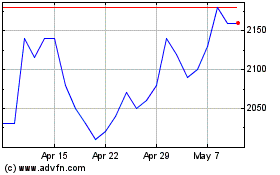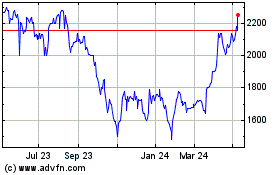Alpha Launches a New Fund Finance Report Revealing the Truth About NAV Facilities and ‘Leverage on Leverage’ Criticism
February 19 2025 - 3:00AM
Business Wire
Alpha Group International plc (LON:ALPH) today announced the
launch of its new fund finance report. Harnessing data from its
Alpha Match platform, this is the only report of its kind to
aggregate heads of terms data to explore the risks of NAV
financing. The findings dispel common assumptions and help to
alleviate concerns around GPs taking on too much debt, as well as
how cautious lenders are when providing these facilities.
This press release features multimedia. View
the full release here:
https://www.businesswire.com/news/home/20250219433701/en/
Alpha Match's new lender book report uses
heads of terms data from loans Alpha Match has placed and
structured over the past 12 months to shine a light on how risky
typical fund finance NAV facilities are. (Graphic: Business
Wire)
The total fund finance market is estimated to be worth $1.2trn,
according to a recent Ares whitepaper. Of that total, NAV lending
represents around $225bn (18.75%), with the bulk of that amount
attributable to secondaries NAV ($175bn), and just $50bn for single
fund NAV facilities – the focus of this report. Furthermore, Ares
estimates that NAV loan usage remains limited at less than 3%.
Despite NAV facilities representing a relatively small
proportion of the fund finance market, the use of these loans has
come under fire in recent years, with the main criticism focused on
what the Bank of England labels as ‘leverage on leverage’. This
resulted in the PRA demanding banks review and assess their current
practices regarding their private markets lending activities. The
Institutional Limited Partners Association (ILPA) also published
NAV guidance to its members, with a particular focus on
communication between LPs and GPs, as well as documentation.
Crucially, all existing reports on the use of NAV facilities
have been based on survey and qualitative research. NAV facilities
have never been tested at scale. Against this backdrop, we have
developed a new report, harnessing data from Alpha Match, to
explore the effects of using a NAV facility during a period of
stress. By aggregating heads of terms data, we are able to explore
the risks of bringing in this particular kind of financing. The
results might surprise you.
The report covers:
- A breakdown of how LTVs vary across facility size
- LTV by the number of assets
- LTV by lender type
- LTV sensitivity testing
Access report
By responding to the leverage on leverage criticism, this report
benefits both fund managers (as borrowers) and their investors in
better understanding the impact of NAV facilities on a fund. It
provides an independent, data-led overview of the current fund
finance market for both GPs and LPs to better understand these
facilities and help with deciding whether or not a NAV loan is
appropriate.
Alpha’s Ben James, Head of Lender Engagement says, “Lenders are
looking at myriad factors when setting the LTV, including the
fund’s portfolio composition, diversification / concentration,
performance, existing leverage levels, realisation certainty and
timeframes, to name but a few. Each lender and individual financing
circumstance will have its own considerations and sensitivities,
meaning lenders structure a financing accordingly to mitigate these
idiosyncratic risks. It is crucial to note that no single financing
situation is the same, both in terms of the lender’s credit
underwrite analysis and the borrower’s purposes for the
financing.”
To find out more about Alpha Match, visit
www.alphagroup.com/match or email match@alphagroup.com
View source
version on businesswire.com: https://www.businesswire.com/news/home/20250219433701/en/
match@alphagroup.com
Alpha (LSE:ALPH)
Historical Stock Chart
From Jan 2025 to Feb 2025

Alpha (LSE:ALPH)
Historical Stock Chart
From Feb 2024 to Feb 2025
